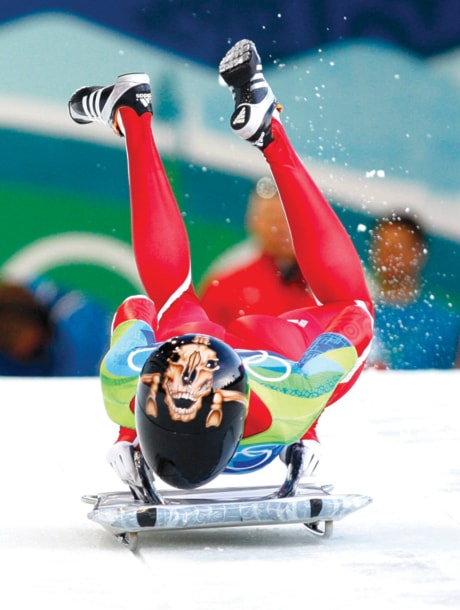WHISTLER, B.C. — It wasn’t Mellisa Hollingsworth’s night at the Whistler Sliding Centre.
Amy Williams of Britain drove a blistering first run Thursday to take the early lead in the women’s Olympic skeleton event, while Hollingsworth has a big hill to climb after finishing third.
The Canadian is the overwhelming gold medal favourite after winning the World Cup title this season. But she was an underwhelming fifth after the first heat, then hit a bump coming out of the start grooves in the push on the second heat.
It wasn’t the way she wanted to kick off the Vancouver Games.
“I’m disappointed, for sure. I’m frustrated a little bit,” said the 29-year-old from Eckville the bronze medal winner from Turin.
“The positive thing I’m drawing out of it is I could have very easily given up when I smashed the wall coming out of the groove, but I kept pushing forward and it’s still a close race. A couple of tenths (of a second) is nothing, especially on this track.”
Williams slid the lights out in the first heat at the Whistler Sliding Centre, roaring down the 1,450-metre course at an average speed of 143.3 km/h to finish in 53.83 seconds, a track record for the women.
The previous mark was 54.30
Her two-run combined time was one minute 47.96 seconds.
Kerstin Szymkowiak of Germany was second, three-tenths of a second back, and Hollingsworth was third, almost-four-tenths of a second off the pace.
“I feel fine now. I’m just trying to enjoy it and try to relax,” said Williams. “I made mistakes, but everyone did and I’ll hopefully go back tomorrow and look through video and try to correct them.”
The final two heats are set for today. The slider with the best combined time in four runs wins gold.
Williams, a 27-year-old from Cambridge, is at her first Games. She failed to make the cut for Turin, but since then has been slowly sliding to the top of the sport. She was fifth at the world championships in 2008, took silver at that same event in 2009 and won silver at Whistler last February at the Olympic test event.
She was steady but not spectacular on the World Cup this year. She finished fourth in three events and was ranked fifth overall coming to Vancouver.
Szymkowiak, on the other hand, is the hottest thing on two runners. The 32-year-old from Mainz, known as the “Ice Tiger,” had a slow start but finished on the podium in her last five consecutive World Cup races heading into the Games. She won gold twice, silver twice and a bronze.
She was third after the first heat, but won the second heat outright to nip at Williams’ heels.
“(The runs) were 90 per cent OK. I have to do the other 10 per cent tomorrow,” said Szymkowiak.
She said she wants to pick up her speed down in the lower runs.
Amy Gough of Abbotsford, B.C., was second after the first heat, but fell off the pace in the second run and ended up tied for seventh with Shelley Rudman of Britain.
“I steered the second run a little too aggressively (because) I knew I had some things to fix from my first run,” said Gough, 32. “You just dig into the ice too much, so it slows your speed down.”
Gough, at her first Olympics, said the sliders drew energy from the large crowd of flag-waving, horn-blowing Team Canada fans.
“The people at the start line are awesome. It definitely fuels the old legs to get moving,” she said.
Michelle Kelly of Fort St. John, B.C., was 13th in the 19-sled field.
“I’m not thrilled. It’s a little frustrating that I’m making mistakes on my home track,” said Kelly, who finished 10th in Salt Lake City in 2002 in her only other Olympic appearance.
“I need to sit down with the coaches tonight and re-evaluate and see what it is I can change and fix.”
The field was reduced to 19 sleds from 20 just before the race when officials disqualified Japanese slider Nozomi Komuro because she did not have an International Bobsleigh Federation sticker on her sled.
The sticker proves the sled has met weight and measurement requirements.
